Study on the Effect of Mining Activities on Floral Diversity in Western Rajasthan
Rohitashav Panwar1 and B. R. Jaipal1 *
DOI: http://dx.doi.org/10.12944/CWE.15.Special-Issue1.07
Copy the following to cite this article:
Panwar R, Jaipal B. R. Study on the Effect of Mining Activities on Floral Diversity in Western Rajasthan. Curr World Environ 2020; Special Issue (Sustainable Mining). DOI:http://dx.doi.org/10.12944/CWE.15.Special-Issue1.07
Copy the following to cite this URL:
Panwar R, Jaipal B. R. Study on the Effect of Mining Activities on Floral Diversity in Western Rajasthan. Curr World Environ 2020; Special Issue (Sustainable Mining). Available from: https://bit.ly/2ZeSQwE
Download article (pdf) Citation Manager Publish History
Select type of program for download
| Endnote EndNote format (Mac & Win) | |
| Reference Manager Ris format (Win only) | |
| Procite Ris format (Win only) | |
| Medlars Format | |
| RefWorks Format RefWorks format (Mac & Win) | |
| BibTex Format BibTex format (Mac & Win) |
Article Publishing History
| Received: | 26-04-2020 |
|---|---|
| Accepted: | 25-06-2020 |
| Reviewed by: | 
 Sneha Gautam
Sneha Gautam
|
| Second Review by: |

 Rakesh Kumar
Rakesh Kumar
|
| Final Approval by: | Prof BB Dhar |
Introduction
Mining is extraction of valuable minerals or other geological materials in or on the earth planet. The mining procedures, the materials are expelled from the earth by stabbing and detonating. The two methods of mining for desolation of nature ore are, opencast (surface mining) and underground mining. Opencast mining process is making for extracting minerals near the surface of the earth or for soft-rocks. The classification of these types of mining is based desired parameters for their application. Open cast mining cause unnecessary air pollution as they produce huge quantities of wastes than underground mining.1 It has therefore become necessary for governments, regulatory agencies, local communities and the industry itself to adopt strategies attributing landscape, flora and fauna properties to ensuring the functionality of reclaimed ecosystem.2 The top soil especially gets seriously damaged during extraction.3 Mining is a worldwide Marvel and has been the reason for concern wherever on the planet, including the propelled nations. In one hand this action has prompted the improvement in different division viz.- social, monetary, transport, educational and industrial etc, and in other hand such huge number of severe concerns related with natural environment. So deterioration in physical, chemical, and biological quality of the environment affects both flora and fauna resources.4
Specifically, usually important to detonate rocks with boring, blasting with explosives and drilling, so as to extricate material however this strategy for extraction offers ascend to heavy noise, it denoted to noise pollution. The other vital ecological issues related to mining of sandstone along with noise pollution are - environmental problems such as - pollution of water and air, depletion of vegetation cover, emergence and growth of xerophytes species, instability of the Mountain, loss of natural resources, fauna and biodiversity and change in land topography, degradation of agriculture land, and also the soil and rock masses. According to Lamb (2001) reclamation is mostly used to refer to re-vegetation of highly degraded site such as mined lands.5
Socio-economic benefits have been generated from mining while there have been unfavorable effects of mining to the ecosystem due to enormous excavation and elimination of soil and rock layers.6 Mining causes huge damage to biological communities and landscapes to the earth.7 During sandstone mining activities involved extraction like-drilling, blasting, loading and transportation by this generate dust into the mining besides areas causes air pollution by SPM (suspended particulate matter). The pollutants released in atmosphere by motorized machines involved during the mining process like-bulldozer, drilling machine, dumper, tractor and other transportation vehicles.
Mining is a major source of economy in Rajasthan but is also a major cause of ecological disturbance due to the land degradation and related changes in the structural and functional characteristics of the native vegetation.8 India has its peerless character on the planet because of the extraordinary decent variety of natural biological communities9 and rich plant variety in its diverse parts.10 It holds approximate 49,000 plant species, 2.4% overall topographical region and 08% biodiversity of the world.11 The plant refines air through the method of photosynthesis and furthermore expels numerous toxicants from air, water and soil.12 The plants assimilate heat and discharge water vapor to retain temperature13 and furthermore increment moistness in environment.14 The plants inhibit soil disintegration15 and enhance soil fecundity.16 In mining boundaries the ecosystems are affected the aquatic and terrestrial bodies and the effects could extend beyond the boundaries of the mining area for a long time period. The mining and quarrying activities are mainly responsible for decreasing of faunal diversity and population distribution of wild life but beneficial to some adaptable species.17
Vegetation is the principle part of earthbound ecosystems.18 Timberland ecosystems give items and administrations that are of incentive to human social orders.19 Vital ecological issues related to mining of sandstone are- environmental problems, on the surrounding area leaving the region appeared scarred with irregular patches.
The resultant to mining, loss of surface and subterranean biodiversity makes an enormously ruthless condition which is unsuitable for restoration of the local biological community20 with high financial esteem, and makes the region unfit for utilization of the local societies. Opencast mining in Chaukari kalan has regularly caused irreversible changes in vegetation, fauna, hydrology, and soil science and the formation of enormous overload dumps. Thusly, disposed of mines are perceived as man-made deserted destinations which have impacts on both an environmental and monetary weight on society.21 Vegetation investigation of this mining region would help in understanding the influence of mining on the floral variety. The mining zone which is under investigation have been undermining from quite a while, therefore, the present examination deals with the plant species diversity and impact of mining exercises in and around Chaukri kalan mining zone.
Materials and Methods
The present study has been carried out at Chaukri kalan open cast mining zones of Jodhpur district, situated at 26°51’09.62”N latitude and 73°66’69.18”E longitude amid July, 2018 to June, 2019 (Fig. 1).
The examination region was inspected in a regular routine amid the field surveys. Field overview was led in each season consistently. Arbitrary points were selected in the study area, the latitude-longitude coordinates were recorded with the assistance of a GPS. In those chosen points the vegetation cover of a 10mX10m region was made with the assistance of ropes and poles. This 100m2 region was then overviewed by getting an exhaustive tally of the quantity of plants in it. The species were identified to the assistance of accessible literature. The native names were solicited from the neighborhood individuals from the concerned zones. Any obscure plant species was either photographed or gathered so as to get it recognized later on. Rest were distinguished, counted and archived.
Data analysis for vegetation cover- Floristic analysis at mined and non-mined zones were estimated using diversity indices like as, richness, diversity and evenness-
Formulas-
Pi= n/N
Where,
n= number of species
N= total number of species observed in all families
Pi LN Pi = Hs
Where,
LN = natural logarithms
Hs= Shannon waiver diversity index
Richness= n/√N
Evenness= Hs/ n
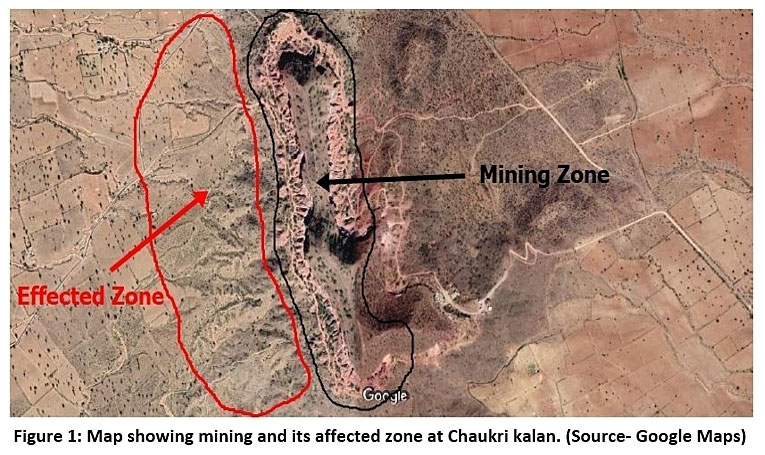 |
Figure 1: Map showing mining and its affected zone at Chaukri kalan. (Source- Google Maps) Click here to view Figure |
Results and Discussion
From the study area an aggregate of 81 diverse plant species have been observed at Chaukri kalan non-mined study site. In which 50 species were of herbs, 14 of shrubs and 17 of trees were observed whereas only 64 plant species were observed in mined area.
In non mined area, the observed diversity indices Simpsons (D) and Shannon Wiener (Hs) were 42.77584 and 4.01195 respectively while in mined area, the diversity indices were observed 27.80326595 and 3.65606 respectively.
The study result shows that in non-mined area Fagonia cretica had highest richness (4.692416) while Ficus bengalensis had lowest (0.01188) and the highest and lowest evenness was observed for Haloptelea integrifolia (8.408658) and Fagonia cretica (1.54508) respectively. The observation of mined area shows that Tephrosia purpuria had highest richness (3.31919) while Sarcostemma acidum, Crotalaria medicaginea, Lucas aspera and Azadirachta indica had similar and lowest richness (0.054413). The highest and lowest evenness in mined area was observed for Sarcostemma acidum (12.14517) and Tephrosia purpuria (1.752363) respectively (Table. 1)
Table 1: Showing richness and evenness of plant species in mined and non-mined zones.
|
Family |
Plant Species |
Habit |
Richness |
Evenness |
Richness |
Evenness |
|
Acanthaceae |
Barleria prionitis |
H |
0.14 |
5.23 |
0.48 |
2.50 |
|
|
Justicia simplex |
H |
0 |
0 |
0.30 |
2.87 |
|
Aizoaceae |
Sesuvium sesuvioides |
H |
0.08 |
7.66 |
0.32 |
2.80 |
|
|
Trianthema portulacastrum |
H |
0.16 |
4.70 |
0.74 |
2.24 |
|
Amaranthaceae |
Achyranthes aspera |
H |
0.08 |
7.66 |
0.97 |
2.10 |
|
|
Aerva lanata |
H |
0.16 |
4.70 |
0.30 |
2.87 |
|
|
Aerva persica |
H |
0.30 |
3.51 |
0.57 |
2.39 |
|
|
Digera muricata |
H |
0.24 |
3.83 |
1.03 |
2.07 |
|
Apocynaceae |
Wrightia tinctoria |
T |
0.11 |
6.07 |
0.51 |
2.46 |
|
Asclepidaceae |
Calotropis procera |
S |
0.98 |
2.35 |
2.55 |
1.72 |
|
|
Leptadenia pyrotechnica |
S |
0.52 |
2.86 |
1.22 |
1.99 |
|
|
Sarcostemma acidum |
S |
0.05 |
12.15 |
0.38 |
2.67 |
|
Asteraceae |
Dicoma tomentosa |
H |
0.49 |
2.91 |
1.73 |
1.85 |
|
|
Oligochaeta ramose |
H |
1.25 |
2.20 |
1.81 |
1.84 |
|
|
Sonchus oleraceus |
H |
0.46 |
2.97 |
1.20 |
2.00 |
|
|
Verbesina encelioides |
H |
0 |
0 |
0.33 |
2.77 |
|
|
Xanthium strumarium |
S |
0.63 |
2.68 |
1.33 |
1.96 |
|
Bignoniaceae |
Tecomella undulate |
T |
0 |
0 |
0.50 |
2.47 |
|
Boraginaceae |
Trichodesma amplexicaule |
H |
0.19 |
4.33 |
0.44 |
2.56 |
|
Brassicaceae |
Lepidium sativum |
H |
0 |
0 |
0.21 |
3.20 |
|
Caesalpinaceae |
Cassia tora |
H |
0.11 |
6.07 |
1.03 |
2.07 |
|
Capparaceae |
Capparis deciduas |
S |
2.83 |
1.81 |
4.32 |
1.57 |
|
Chenopodiaceae |
Chenopodium album |
H |
0 |
0 |
0.32 |
2.80 |
|
|
Salsola baryosma |
S |
0.163 |
4.70 |
0.87 |
2.15 |
|
Cleomaceae |
Cleome viscosa |
H |
0.30 |
3.51 |
1.24 |
1.99 |
|
Combretaceae |
Anogeissus pendula |
T |
0.73 |
2.55 |
2.20 |
1.77 |
|
Convolvulaceae |
Convolvulus deserti |
H |
0.08 |
7.66 |
0.55 |
2.41 |
|
Cyperaceae |
Cyperus bulbosus |
H |
0.71 |
2.58 |
1.40 |
1.94 |
|
|
Cyperus rotundus |
H |
0.84 |
2.45 |
1.71 |
1.86 |
|
Euphorbiaceae |
Euphorbia caducifolia |
S |
0.08 |
7.66 |
0.65 |
2.31 |
|
|
Euphorbia hirta |
H |
0 |
0 |
0.21 |
3.20 |
|
Fabaceae |
Acacia nilotica subsp. Cupressiformis |
T |
2.12 |
1.93 |
3.17 |
1.65 |
|
|
Acacia senegal |
T |
0 |
0 |
0.38 |
2.67 |
|
|
Crotalaria medicaginea |
H |
0.05 |
12.15 |
0.55 |
2.41 |
|
|
Indigofera oblongifolia |
H |
0.08 |
7.66 |
0.31 |
2.84 |
|
|
Parkinsonia microphylla |
T |
0 |
0 |
0.05 |
6.66 |
|
|
Prosopis cineraria |
T |
0.71 |
2.58 |
0.94 |
2.11 |
|
|
Prosopis juliflora |
S |
1.01 |
2.33 |
1.46 |
1.92 |
|
|
Tephrosia purpuria |
H |
3.32 |
1.75 |
4.51 |
1.56 |
|
Lamiaceae |
Anisomeles indica |
H |
0.52 |
2.85 |
0.77 |
2.21 |
|
|
Lucas aspera |
H |
0.05 |
12.15 |
0.21 |
3.20 |
|
|
Ocimum americanum |
S |
0 |
0 |
0.07 |
5.16 |
|
Mimosaceae |
Acacia nilotica |
T |
0.41 |
3.11 |
1.16 |
2.01 |
|
Meliaceae |
Azadirachta indica |
T |
0.05 |
12.15 |
0.53 |
2.43 |
|
Myrataceae |
Eucalyptus camaldulensis |
T |
0 |
0 |
0.05 |
6.66 |
|
Molluginaceae |
Mollugo cerviana |
H |
0.11 |
6.07 |
0.51 |
2.46 |
|
Moraceace |
Ficus bengalensis |
T |
0 |
0 |
0.01 |
0 |
|
|
Ficus religiosa |
T |
0 |
0 |
0.05 |
6.66 |
|
Moringaceae |
Moringa oleifera |
T |
0 |
0 |
0.05 |
6.66 |
|
Nyctaginaceae |
Boerhavia diffusa |
H |
0.11 |
6.07 |
0.40 |
2.62 |
|
Papaveraceae |
Argemone Mexicana |
H |
0.08 |
7.66 |
0.46 |
2.52 |
|
Pedaliaceae |
Pedalium murex |
H |
1.14 |
2.25 |
2.55 |
1.72 |
|
Plantaginaceae |
Bacopa monnieri |
H |
0.08 |
7.668 |
0.32 |
2.80 |
|
Poaceae |
Aristida adscensionis |
H |
0.46 |
2.97 |
1.02 |
2.07 |
|
|
Cenchrus biflorus |
H |
1.01 |
2.33 |
2.54 |
1.72 |
|
|
Cenchrus ciliaria |
H |
0.38 |
3.19 |
1.45 |
1.92 |
|
|
Cenchrus setigerus |
H |
0.79 |
2.50 |
1.98 |
1.80 |
|
|
Dactyloctenium sindicum |
H |
0.46 |
2.97 |
0.80 |
2.20 |
|
|
Dichanthium annulatum |
H |
0.60 |
2.72 |
1.22 |
1.99 |
|
|
Digitaria bicornis |
H |
0.14 |
5.23 |
0.48 |
2.50 |
|
|
Eragrostis minor |
H |
0.38 |
3.19 |
0.97 |
2.10 |
|
|
Ochthochloa compressa |
H |
0.33 |
3.39 |
0.87 |
2.15 |
|
|
Oropetium thomaeum |
H |
0.57 |
2.77 |
1.18 |
2.01 |
|
|
Protis indica |
H |
0.08 |
7.66 |
0.44 |
2.56 |
|
|
Saccharum spontaneum |
H |
1.06 |
2.30 |
1.39 |
1.94 |
|
|
Sporobolus diander |
H |
0.49 |
2.91 |
1.49 |
1.91 |
|
Polygonaceae |
Calligonum poligonoides |
S |
0.11 |
6.07 |
0.87 |
2.15 |
|
Rhamnaceae |
Ziziphus mauritiana |
S |
0.08 |
7.66 |
0.50 |
2.47 |
|
|
Ziziphus nummularia |
S |
1.25 |
2.20 |
2.00 |
1.80 |
|
Rubiaceae |
Borreria articularis |
H |
0.11 |
6.07 |
0.52 |
2.44 |
|
Salvadoraceae |
Salvadora oleoides |
T |
0 |
0 |
0.05 |
6.66 |
|
|
Salvadora persica |
T |
0 |
0 |
0.06 |
5.74 |
|
Solanaceae |
Datura stramonium |
S |
1.52 |
2.09 |
2.70 |
1.70 |
|
|
Solanum surattense |
H |
0.65 |
2.65 |
1.00 |
2.08 |
|
|
Vithania somnifera |
H |
0.16 |
4.70 |
0.86 |
2.16 |
|
Tiliaceae |
Corchorus depressus |
H |
0.73 |
2.55 |
1.41 |
1.93 |
|
|
Grewia tenax |
S |
0.46 |
2.97 |
2.00 |
1.80 |
|
Ulmaceae |
Holoptelea integrifolia |
T |
0 |
0 |
0.04 |
8.41 |
|
Zygophyllaceae |
Balanites aegyptica |
T |
0 |
0 |
0.34 |
2.74 |
|
|
Fagonia cretica |
H |
2.23 |
1.91 |
4.69 |
1.55 |
|
|
Tribulus terrestris |
H |
1.14 |
2.25 |
1.35 |
1.95 |
|
|
|
|
(D) M = 27.80 |
Hs M = 3.66 |
(D) NM = 42.78 |
Hs MN =4.01 |
The mining action reasonably ruins the vegetation cover. The diversity indices of the mining site showed the big difference to non-mined site. The non-mined zone had higher Simpsons (D) and Shannon Wiener (Hs) indices as compared to mined zone. The investigation site has rich sources from floral biodiversity purpose of perspectives.
Habitat annihilation is the leading cause of species extinction and biodiversity loss in natural ecosystems.22, 23 In mining activities the blasting technique produces harmful gases and dust particles (as SPM). These dust particles mixed with gaseous composition and deposited on the upper and lower surface of leaves, so the upper and lower surface stomata were closed with thin layer of dust (Fig. 2). It causes less gases exchange and pigment loss of leaves. In other hand the thin layer of dust blocks the absorption of sun energy by leaf, which causes decreased photosynthesis and respiration; it results in the plant senescence or plant death. Deposition of mined exhausted toxic and harmful particles on upper layer of soil caused changes in soil physio-chemical parameters and surface texture composition (acidic/ alkaline/ saline/ toxicity), consequently this type of soil would not be useful for vegetation growth. The stones/rocks of the size beyond what 25cm could seriously influence the root entrance of plants and result in stunted development, that too when the level of stones surpasses 50-60(%) of soil.24 According to Haule et al. limestone mining in the study area exposed to devastate natural vegetation and it was revealed by the existence of the large mining pit found in the study area covering about 38.25 ha of the forest cleared for limestone mining. It had also substantiated by 61.7% of the respondents who noticed an increase in deforestation in Usongwe Division.25 Biswas et al. also concluded that the floral diversity was disturbed by opencast mining in Sonepur Bazari of Raniganj coalfield area, West Bengal.26 International Council on Mining & Minerals (July 2005) recommend that, there ought to be precise arranging and biodiversity balances while building up mining industries, so harm because of mining could be redressed.27
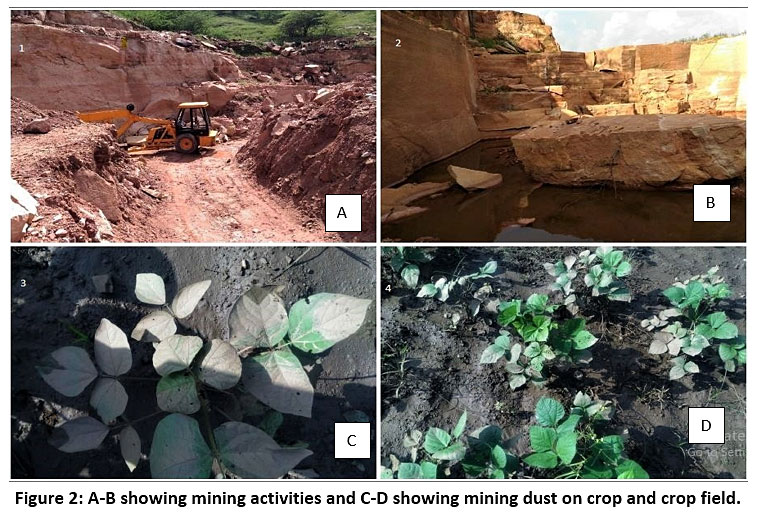 |
Figure 2: A-B showing mining activities and C-D showing mining dust on crop and crop field. Click here to view Figure |
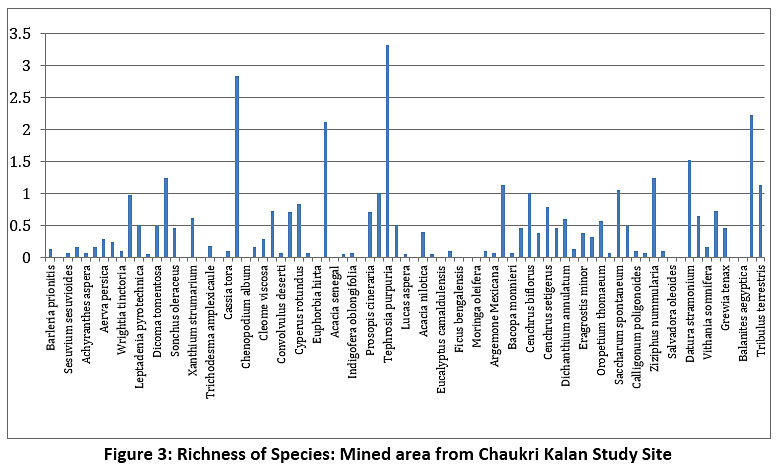 |
Figure 3: Richness of Species: Mined area from Chaukri Kalan Study Site Click here to view Figure |
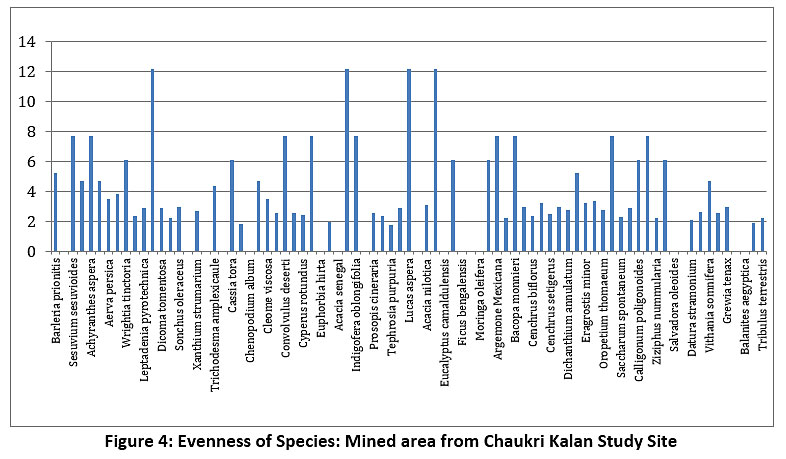 |
Figure 4: Evenness of Species: Mined area from Chaukri Kalan Study Site Click here to view Figure |
 |
Figure 5: Richness of Species: Non mined area from Chaukri Kalan Study Site Click here to view Figure |
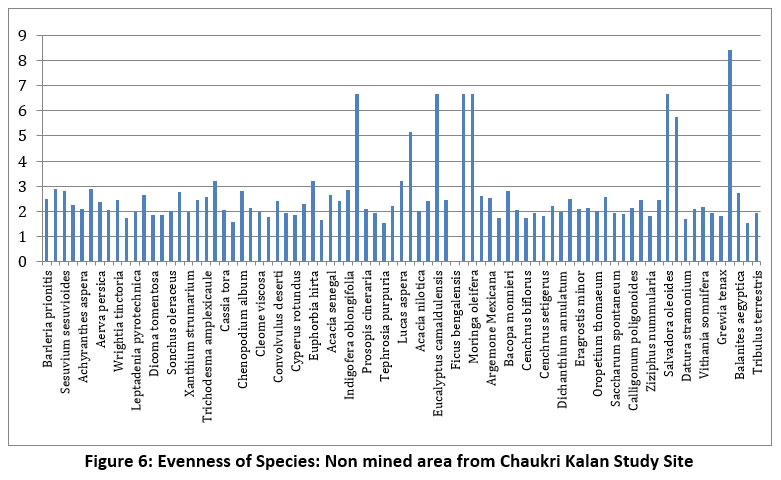 |
Figure 6: Evenness of Species: Non mined area from Chaukri Kalan Study Site Click here to view Figure |
Conclusion
The stone mining at Chaukri kalan site has incredibly influenced the natural environment and vegetation diversity. Plants have been stripped off their normal territory because of stone mining exercises. The nonappearance of natural vegetation has extraordinarily expanded the danger of gorge disintegration in mining territories. The outcome investigation shows that mining tasks are directly or in a indirect way influences the vegetation, changes the soil surface and climatic condition. So it can be presumed that the mining tasks influences the nearby plants diversity and climatic conditions of encompassing regions. The present study is limited to sand stone mining area and its surrounding vegetation which showed the depletion impact on floral diversity. It is necessary to conduct further research on other types of mines to get satisfactory information about mining impacts on surrounding floral diversity.
Acknowledgement
The authors are thankful to Head, Department of Zoology, Jai Narain Vyas University, Jodhpur, for providing research facilities. Thanks are due to Dr. Harshvardhan Singh, Surendra Jaipal, Prakash Panwar and Tejendra Kumar for precious support in field work. Sincere thanks to the entire civilians at the study site to behave in a cooperative manner and providing all types of assistances and valuable information as needed.
Funding
The author(s) received no financial support for the research, authorship, and/or publication of this article.
Conflict of Interest
The authors do not have any conflict of interest.
References
- Sharma R, Madhuri S. Renu, L. Monitoring and Assessment of Soil Quality near Kashlog limestone mine at Darlaghat District Solan. Journal of Environment and Earth Science, 2013, 3(2); 34-42.
- Elliot P. G, Grandner J, Allen D, Butcher G. Complition criteria for Alcoa of Australia Limited bauxite mine rehabilitation: 3rd international and 21st annual minerals council of Australia environmental workshop 2. Newcastle, Minerals Council of Australia Canberre. 1996; 79-89.
- Sheoran V. Soil reclamation of abandoned mine land by re-vegetation: A review. Int. J. Soil, sedi. water. 2008;3(2): 13.
- Arvind K. Biswajit P. Degradation of soil quality parameters due to coal mining operations in Jharia coalfield, Jharkhand India, Journal of Advance Laboratory Research Bio, 2011, 2.
- Lamb D. Reforestation of degraded tropical forest land in Asia – Pacific. J. Trop. For. Sci., 2001;9: 1-5.
- Joseph Y. Yeboah, B. A. Environmental and health impact of mining on surrounding communities: A case study of Anglogold Ashanti in Obuasi. Master Thesis, Kwame Nkrumah University of Science and Technology, 2008.
- Down C. G, Stocks J. Environmental Impact of Mining. London: Applied Science Publishers. 1977;
- Kumar N, Kumar A. Floristic Diversity Assessment in River Sand Mining near Palri Bhoptan Village, Kisangarh Tehsil, Ajmer District, Rajasthan, India. Asian Journal of Earth sciences. 2014, 7 (2); 51-59.
- Saini S, Yadav J. P. Genetic variation in natural populations of Salvadora oleoides: An important medicinal plant that needs conservation. Asian J Plant Sci Res. 2013;3(5): 20-27.
- Mahalingam R, Bharathidasan R, Ambikapathy V, Panneerselvam, A. Studies on antibacterial activity of some medicinal plant against Human pathogenic Micro Organism. Asian J. Plant Sci. Res. 2011;1(3): 86-90.
- Gireesha J, Raju N. S. Ethno botanical study of medicinal plants in BR Hills region of Western Ghats, Karnataka. Asian J. Plant Sci. Res., 2013;3(5): 36-40.
- Monio M, Iglesias D. A. Plants and the environment. ESPERE Climate Encyclopaedia, 2004; 5-12.
- Kurniawan S. How do plants affect the temperature. A Project on California State. Science Fair, J. 2004; 9-15
- Valsson S. Bharat D. A. Time Space and People. 2011; 38-41.
- Zuazo V. H. D, Pleguezuelo C. R. R. Soil- erosion and runoff prevention by plant covers- A review. Int. J. Agro. Sustain. Dev. 2008;28(1): 65-86.
- Russell E.W. Organic matter and soil fertility, J. Philo. Trans. Royal Soci. Bio. Sci. 1977;281(290): 209-219.
- Panwar R, Jaipal B. R. The mining activities and its impact on diversity and population of vertebrates, around Khejarla village of western Rajasthan. Int. J. Res. Ana. Rev. 2019;6(1): 992-998.
- Godínez-Alvarez H, Herrick J. E, Mattocks M, Toledo D, VanZee J. Comparison of three vegetation monitoring methods: their relative utility for ecological assessment and monitoring. Ecol. Indic. 2009;9(5); 1001–1008.
- Turner R, Daily G. The Ecosystem Services Framework and Natural Capital Conservation. Environ. Resour. Econ.. 2008:39; 25-35.
- Requena N, Pérez-Solis E, Azcón-Aguilar C, Jeffries P, Barea J.M. Management of indigenous plant-microbe symbioses aids restoration of desertified ecosystems. Appl. Environ. Microbiol. 2001;67: 495-498.
- Sharma G. P, Raghubanshi A. S. How Lantana invades dry deciduous forest: a case study from Vindhyan highlands, India. Trop. Ecol. 2010;51: 305-316.
- Koh L.P, Dunn R. R, Sodhi N.S, Colwell R.K, Proctor K.C, Smith V.S. Species coextinctions and the biodiversity crisis. Science, 2004, 305: 1632-1634.
- Pimm S.L, Raven P. Biodiversity: Extinction by numbers. Nature, 2000, 403: 843-845.
- Stone E. L, Kaliz P. J. On the Maximum Extent of tree roots. Forest Ecology & Management, Elsevier Science Publishers, B.V. Amsterdam, 1991;46: 59-102.
- Haule H, Ringo J, Luvinga K, Kawonga S, Mayengo G, Morsardi L. Effects of Limestone Mining on Deforestation and Land Degradation in Mbeya Region, Tanzania. International Journal of Modern Social Sciences, 2016, 5(2): 117-132.
- Biswas C. K, Mishra P, Mukherjee A. Floral diversity in sites deranged by opencast mining in Sonepur Bazari of Raniganj coalfield area, West Bengal. Journal of Applied and Pure Biology. 2013; 28(2):265-73.
- Council on Mining & Minerals, July 2005. Biodiversity Offsets-A Briefing paper for the Mining Industry. 2005.







